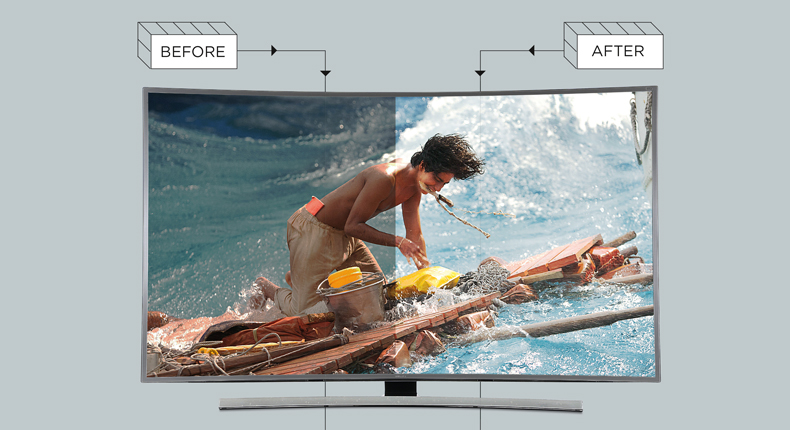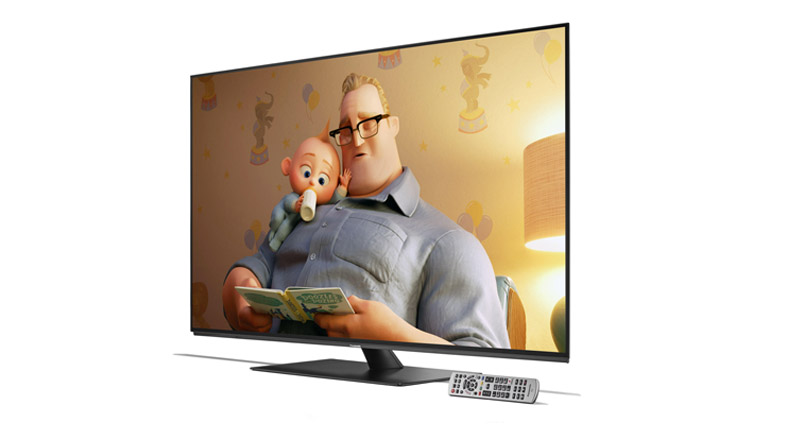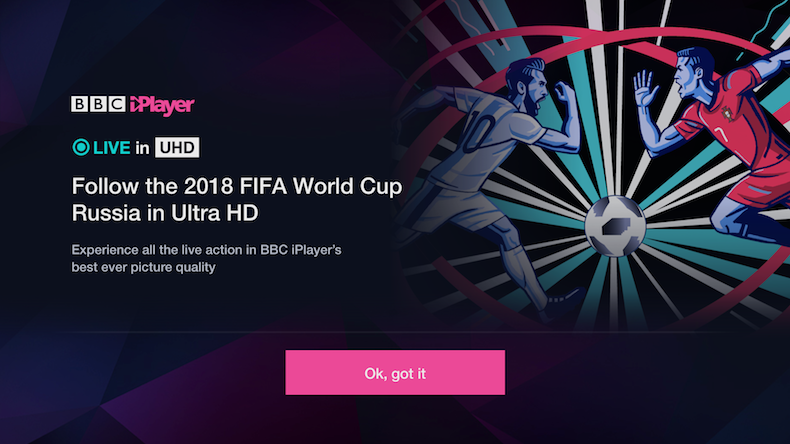Hybrid Log Gamma (HLG): the 4K HDR TV broadcast format explained
When it comes to the ultimate 4K HDR TV broadcasts, it's all about HLG

While most AV fans embrace the picture quality improvements you get with HDR (High Dynamic Range) technology, most people could do without the brain-melting complexity and barrage of acronyms that come with it.
Unfortunately, HDR has only got more complicated since launch, as we find ourselves having to get to grips with a wide range of HDR formats, from Dolby Vision to HDR10+, and Hybrid Log Gamma.
What is Hybrid Log Gamma (HLG)?

It’s hard to think of a less friendly name for anything than Hybrid Log-Gamma (which, for the sake of everyone’s sanity, we’ll refer to as HLG from here on in). Yet it’s a term that you shouldn't ignore if you're thinking about buying a 4K HDR TV.
At its heart, HLG is mercifully more simple than it sounds. The result of a joint research project between the BBC in the UK and Japanese national broadcaster NHK, it’s designed to deliver a more convenient HDR solution for the broadcast world than the HDR10 system used by most current HDR sources and displays.
Why is HLG more convenient? It combines standard dynamic range and high dynamic range images into just one video signal that can play as SDR on SDR screens or HDR on (HLG-compatible) HDR screens, ensuring viewers aren't left in the dark, no matter what TV they have.
These ‘one size fits all’ signals can be delivered in just one bitstream in the VP-9 or HEVC compression formats or over HDMI. They won’t eat up precious broadcast bandwidth in the way that separate SDR and HDR signals would, either, and they can even fit within the existing 10-bit production workflows broadcasters are already using.
All of this is hugely helpful for broadcasters who increasingly need to deliver HDR efficiently and consistently on live feeds.
The latest hi-fi, home cinema and tech news, reviews, buying advice and deals, direct to your inbox.
Hopefully, you’re following so far, as there’s one more horribly technical phrase to introduce to explain how HLG achieves its seemingly miraculous triumvirate of broadcast HDR benefits: the Electro-Optical Transfer Function. Or EOTF for short.
The simplest explanation for EOTF is that it defines the relationship between a recorded electrical video signal and image brightness. Video displays can then use this information to convert digital signal data into visible light. What HLG does is use a ‘hybrid’ EOTF that employs two different types of light coding.
With low-light content in an image, the HLG system employs the typical gamma curve approach to rendering picture brightness that’s been a feature of TV playback for decades. This means that these parts of the HLG signal can be recognised by SDR TVs and played back normally.
However, the HLG signal also applies a logarithmic curve to the high-brightness parts of its image data that SDR TVs ignore but can be recognised and worked with by compatible HDR TVs, opening up an image with a much wider brightness range.
How can you watch HLG?

So does this mean that HLG will work on any HDR-capable TV? Sadly not. An HDR TV will need to recognise the logarithmic curve HLG uses. The good news is that with live 4K broadcasts now gaining momentum, it's becoming imperative new TV sets support the technology.
Most big-name manufacturers have been selling HLG-compatible TVs since 2018, and Samsung, Sony, LG and Panasonic even added support to a number of their pre-2018 models via software updates.
It's now relatively hard to buy a TV that supports HDR and doesn't support HLG. At the very least, an HDR TV is expected to support HDR10 and HLG, with Dolby Vision and/or HDR10+ being the icing on the cake.
The tech is gradually making its way to other devices, too, including projectors such as the Sony VPL-VW290ES and Epson EH-TW7100, and even Apple's iPhone 12 series of iPhones (these even include HLG video recording via Dolby Vision 8.4, which adds a Dolby Vision metadata layer on top of HLG footage).
That said, it's still worth not taking HLG support for granted, particularly when looking at TVs at the more affordable end of the spectrum. It's always worth delving into a TV or projector's tech specs to double-check, and the BBC regularly updates a list of compatible TV devices for its UHD trials. However, a TV on this list is guaranteed to playback iPlayer's streams in 4K and not necessarily with HLG.
What HLG content is available?

In the early days of HLG, we only had demos shown at technology shows and press events to illustrate what the format's potential could be.
All that changed in December 2017, when the BBC launched the seven-episode Blue Planet II in 4K and HLG HDR on its iPlayer service. It was the first time a full series had been shown in both technologies – no mean feat, and it looked fantastic.
It was a huge step forward from the four-minute clip of Planet Earth II streamed in 4K and HLG in December 2016. However, most people would have seen this 4K clip in SDR, as not many TVs at the time would have supported the HLG format. HLG updates were rolled out for a lucky few during the trial, though.
Then in 2018, the BBC brought out the big guns. Along with trials of the FA Cup final, a rugby fixture, and the Royal Wedding (in conjunction with Sky), most of its matches from the 2018 FIFA World Cup and 2018 Wimbledon Champions were successfully shown live in 4K HLG on iPlayer. Fast forward to 2021, and the BBCs allocation of Euro matches and the entirety of Wimbledon were broadcast in HLG on iPlayer.
During the height of the pandemic in 2020, there was a hiatus in the availability of the BBC's UHD trial content in HLG and 4K as the company joined other streaming services in trying to alleviate the burden on broadband networks. iPlayer has since made its UHD HLG programming available again. The current trial has ten shows available to stream, including His Dark Materials and Black Narcissus.
When Sky joined the HDR party in May 2020, it also adopted the use of HLG, announcing that its Sky Q set-top box would support the format. Sky Q's HLG HDR offering is growing all the time. It already includes several Sky Nature shows, around 100 movies, and some Sky Originals, including Intergalactic, Breeders (Season 2) and Bloods. A partial list of the most recent additions is available here, but you can easily identify the enhanced content by looking for the 'HDR' label appearing in the place of the existing 'UHD' tag (all HDR content on Sky is also in UHD).
Sky's first venture into live HDR sports broadcasting begins with the over 200 hours of live 4K HLG action from the Tokyo Olympics and is set to continue with the 2021/22 Premier League season.
What's the future for HLG?

Despite Sky's best efforts, it's fair to say that HLG is still really trickling rather than flooding onto our TV screens, but there’s little doubt that both is and the BBC are intending to use it more and more.
With the BBC's 4K trials getting such positive feedback – and the Beeb itself has said all these trials so far have been a learning process towards future broadcasts – it seems inevitable that there will be a broader rollout of 4K HLG HDR content in the near future.
Unfortunately, despite the BBC having the rights to broadcast 350 hours of the Tokyo Olympics coverage in the UK, plans to present at least some of that footage in 4K and HLG via the iPlayer app were derailed by the pandemic. That's despite Comcast broadcasting The Games in 4K Dolby Vision and Dolby Atmos in the US and Sky's Eurosport 4K broadcasting from Tokyo live in HLG an ultra HD.
Elsewhere, Mediapro/Overon announced it would transmit the Spanish Football League in HLG, while Google has stated that YouTube’s HDR videos will support HLG encoding. Digital UK also included support for HLG in its 2017 specifications for its Freeview Play platform. Eutelsat's Hot Bird video service offers the HLG-enabled Travelxp 4K channel.
Other HDR formats, such as HDR10+ and Dolby Vision, might be vying for your attention when it comes to streaming and discs, but HLG is still the one to watch when it comes to 4K HDR TV broadcasts.
MORE:
These are the best HDR TVs you can buy right now
Andy is Deputy Editor of What Hi-Fi? and a consumer electronics journalist with nearly 20 years of experience writing news, reviews and features. Over the years he's also contributed to a number of other outlets, including The Sunday Times, the BBC, Stuff, and BA High Life Magazine. Premium wireless earbuds are his passion but he's also keen on car tech and in-car audio systems and can often be found cruising the countryside testing the latest set-ups. In his spare time Andy is a keen golfer and gamer.

